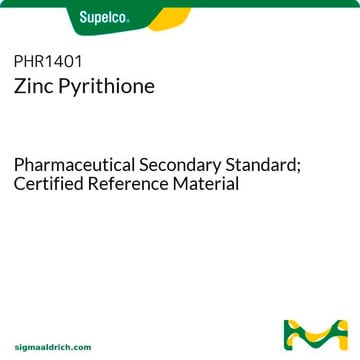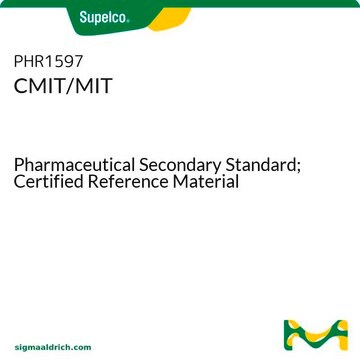134708
2-Bromo-2-nitro-1,3-propanediol
98%
Synonyme(s) :
BNPD, BNPK, Bronopol
About This Item
Produits recommandés
Pureté
98%
Forme
crystals
Pf
130-133 °C (lit.)
Solubilité
H2O: soluble 100 mg/mL, clear, colorless to faintly yellow
Chaîne SMILES
OCC(Br)(CO)[N+]([O-])=O
InChI
1S/C3H6BrNO4/c4-3(1-6,2-7)5(8)9/h6-7H,1-2H2
Clé InChI
LVDKZNITIUWNER-UHFFFAOYSA-N
Vous recherchez des produits similaires ? Visite Guide de comparaison des produits
Application
- Effect of leave-on cosmetic antimicrobial preservatives on healthy skin resident Staphylococcus epidermidis.: This study examines the impact of various antimicrobial preservatives, including 2-Bromo-2-nitro-1,3-propanediol, on the microbiota of healthy skin, particularly focusing on Staphylococcus epidermidis. The findings suggest that such preservatives can influence the skin′s microbial balance, which is essential for maintaining skin health (Zhang et al., 2023).
- Assessing the residual antibacterial activity of clinical materials disinfected with glutaraldehyde, o-phthalaldehyde, hydrogen peroxide or 2-bromo-2-nitro-1,3-propanediol by means of a bacterial toxicity assay.: This research assesses the residual antibacterial effects of various disinfectants, including 2-Bromo-2-nitro-1,3-propanediol, on clinical materials, contributing to improved disinfection protocols in healthcare settings (Lerones et al., 2004).
- Development and testing of a microbiological assay to detect residual effects of disinfectant on hard surfaces.: This study developed a microbiological assay to evaluate the residual effects of disinfectants, including 2-Bromo-2-nitro-1,3-propanediol, on hard surfaces, aiming to enhance surface disinfection strategies in various industries (Mariscal et al., 1999).
Clause de non-responsabilité
Mention d'avertissement
Danger
Mentions de danger
Conseils de prudence
Classification des risques
Acute Tox. 4 Dermal - Acute Tox. 4 Oral - Aquatic Acute 1 - Aquatic Chronic 1 - Eye Dam. 1 - Skin Irrit. 2 - STOT SE 3
Organes cibles
Respiratory system
Code de la classe de stockage
4.1B - Flammable solid hazardous materials
Classe de danger pour l'eau (WGK)
WGK 3
Équipement de protection individuelle
dust mask type N95 (US), Eyeshields, Faceshields, Gloves
Certificats d'analyse (COA)
Recherchez un Certificats d'analyse (COA) en saisissant le numéro de lot du produit. Les numéros de lot figurent sur l'étiquette du produit après les mots "Lot" ou "Batch".
Déjà en possession de ce produit ?
Retrouvez la documentation relative aux produits que vous avez récemment achetés dans la Bibliothèque de documents.
Les clients ont également consulté
Notre équipe de scientifiques dispose d'une expérience dans tous les secteurs de la recherche, notamment en sciences de la vie, science des matériaux, synthèse chimique, chromatographie, analyse et dans de nombreux autres domaines..
Contacter notre Service technique


![1,8-Diazabicyclo[5.4.0]undéc-7-ène 98%](/deepweb/assets/sigmaaldrich/product/structures/120/564/5b373e23-1624-489c-8efb-692de0f96ffb/640/5b373e23-1624-489c-8efb-692de0f96ffb.png)















